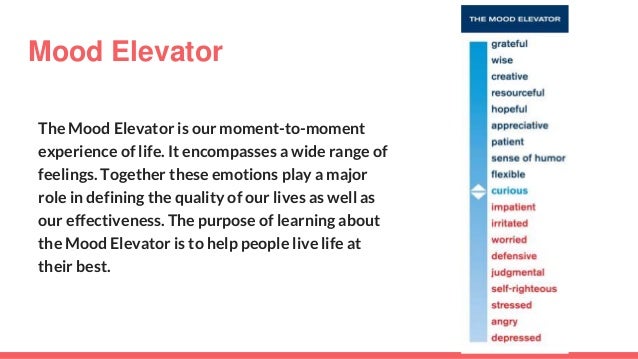Mood Elevator
This is a leadership principle that looks at our moment by moment experiences and our emotional responses to them. Here is an example of the mood elevator

The reason that I believe this is so beneficial is that it helps people to take a minute to stop and check themselves. It helps an individual become self-aware of where they are in that moment and how they are emotionally responding. This enables them to use that knowledge and look at whether it is an appropriate response or think of ways that can bring their mood up to the curious level if they find themselves low on the elevator. This is really important for me because I believe that our emotions have a huge impact on our words and behaviors and so knowing what mood you are feeling is vital in order to control or change your behaviors.
The reason the curious level is where we want people to stay is that when you are at least curious you are open to hearing information, and questioning things including your own thoughts an feelings. Being curious allows your mind to be open instead of closed off. This is vital when it comes to self-leadership. In order to lead others well you first have to be able to lead yourself. Thus learning how to pinpoint your mood and lift it to a neutral zone will play a key role in growing your ability to handle difficult and tense situations as well as how you portray and come across to those who you are leading. You will better be able to guide them if your own negative emotions are not getting in the way.
This principle is one that can be implemented during my education in the social work program, for example when I might become stressed or overwhelmed or be frustrated with a classmate or assignment being able to stop and check my mood and take steps to increase my level on the elevator will be of great benefit throughout this next year and will enable me to be more effective and productive in my studies. I also believe that once entering into the field of social work it will be a really beneficial tool to be able to teach to my clients and help them learn the importance of looking at where their mood is during different moments and situations. Teaching them skills to help with that such as pattern interrupts, stopping their thinking, taking breaks and trying to change their perspective.